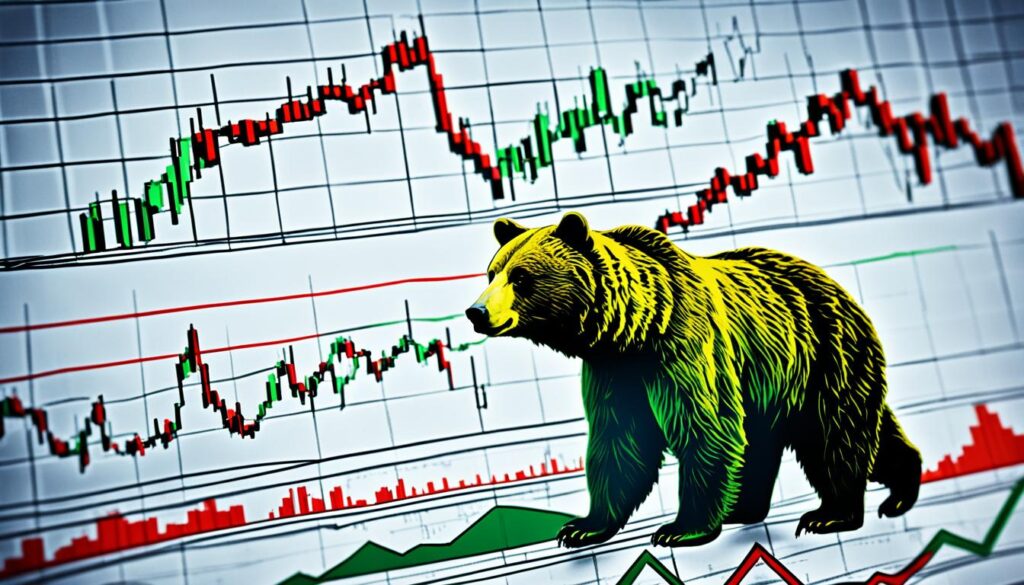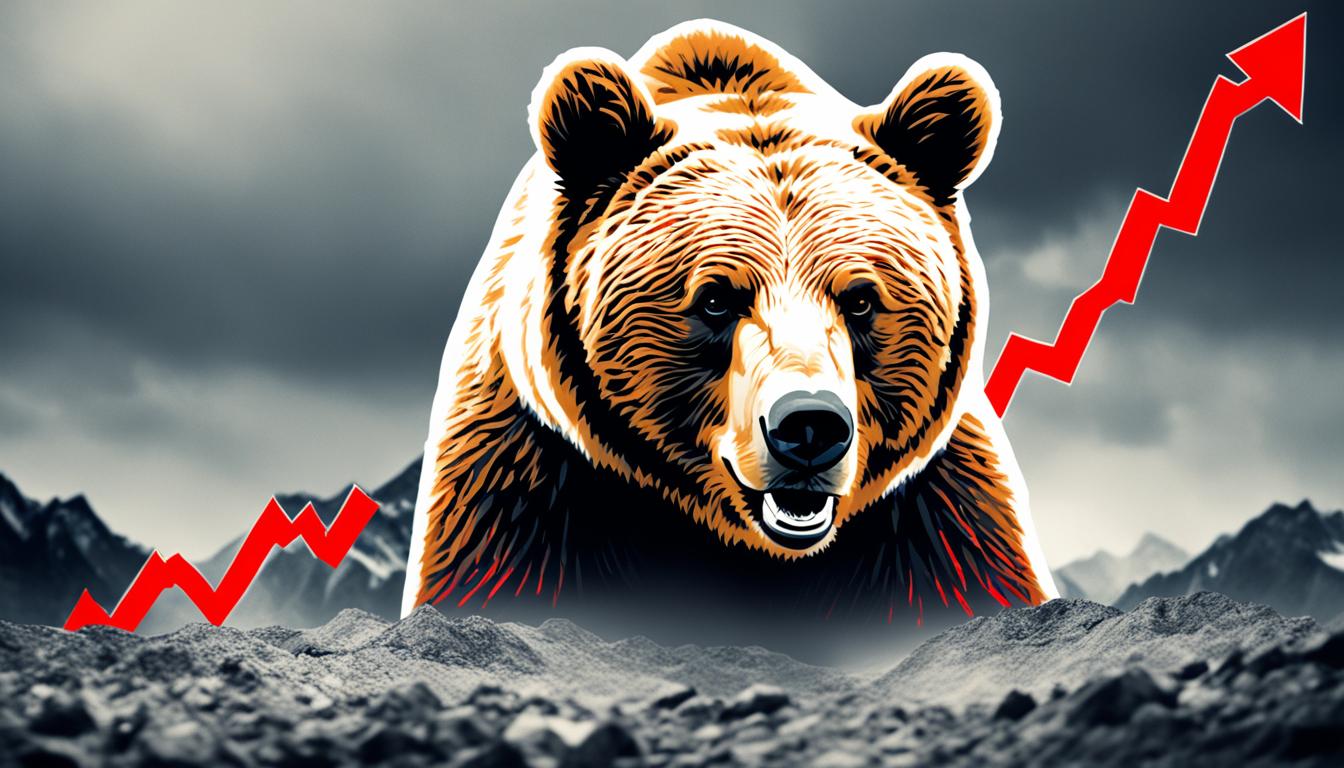What is a Bear Market in Forex Trading?
Between 1900 and 2018, the Dow Jones saw nearly 33 bear markets. That’s about one every three years. It shows how often the market can turn bearish.
A bear market in Forex trading means currency values drop significantly. This drop is usually 20% or more from their recent highs. It happens when many people sell their investments, leading to a market downturn.
Unlike a bull market, a bear market moves downward. Investors are often scared during these times. Bear markets last from a few weeks to several years. They begin due to recessions, market bubbles, or big events like the COVID-19 pandemic in 2020.
Key Takeaways
- Bear markets in Forex trading signify a significant drop in currency values, often exceeding 20%.
- Negative investor sentiment and widespread liquidation are common during these periods.
- Cyclical bear markets recur approximately every three years, highlighting the importance of preparedness.
- Bear markets can be triggered by economic recessions, geopolitical events, or major disruptors like global pandemics.
- Understanding Forex trading downturns and prolonged price declines helps mitigate risks and enhance trading strategies.
Understanding the Bear Market in Forex Trading
In forex trading, a bear market means asset values fall by 20% or more for a while. It’s key to understand bearish trading conditions as the market changes because of issues like economic slow-downs or big crises. During these times, knowing how to analyze the market downturn helps traders deal with tough moments.
A market correction comes before a bear market, with asset values dropping by 10%. In forex market cycles, sellers (bears) are in charge while buyers (bulls) step back. This makes having the right strategy very important in bearish trading conditions.
For a bear market, traders should look closely at situations, compare choices, and then decide carefully. In this market, day trading might bring quick wins, while others might make big buys hoping for better times ahead.
It’s smart to use multi-level stops and technical analysis tools when things move fast. Also, understanding why the market falls is critical. Bearish trading conditions are a perfect time to practice in a demo account until you’re ready for the real deal.
To really get forex market cycles, you have to see how bear markets affect everything. By mixing bullish and bearish investments smartly, you can possibly earn more. Here is a look at different forex market types:
| Market Type | Condition | Typical Duration |
|---|---|---|
| Bear Normal | Decreasing Asset Prices | A few weeks to two years |
| Bear Volatile | Rapid Declines and Fluctuations | A few weeks to several months |
| Bull Normal | Increasing Asset Prices | A few months to several years |
| Bull Volatile | Rapid Increases and Fluctuations | Several months to years |
| Sideways Quiet | Stable Prices with Limited Fluctuations | Variable |
| Sideways Volatile | Fluctuations without a Clear Trend | Variable |
Doing well in bearish trading conditions means picking the right trading system for the market trend. That’s why it’s vital for traders to keep analyzing forex market cycles.
Phases of a Bear Market
A bear market shows falling prices over time. This is often due to signs like slow GDP, high job losses, and weak company profits. Knowing the different phases of a bear market is key for investors. It helps them deal with these hard times.

First Phase: High Prices and Investor Sentiment
The first stage of a bear market is when prices are at their highest. It’s also when investors feel the most sure. They are very confident, which makes the market seem very active. But, when this high point is reached, smart investors start cashing out. This prepares the market for a fall.
Second Phase: Sharp Decline and Panic
Soon, prices start to drop rapidly. This is known as the market collapsing. Panic selling begins, as investors sell quickly to stop losses. As more sell and company profits fall, things go from bad to worse. This deepens the panic.
Third Phase: Speculation and Temporary Rallies
The third part sees short-term rallies and speculative trading. Some investors see a chance to make money at lower prices. These quick jumps in prices are not lasting, though. Unfortunately, the long-term trend keeps going down.
Fourth Phase: Continued Decline and Slow Recovery
In the last phase, prices keep falling but at a slower pace. This can last for quite a while. Eventually, lower price tags and some positive news attract investors again. This marks the lowest point of the bear market. It hints at the start of recovery, possibly leading to a bull market.
| Phase | Key Characteristics | Outcomes |
|---|---|---|
| First Phase | High Prices, High Investor Confidence | Onset of Bearish Trend |
| Second Phase | Sharp Decline, Trading Panic | Investor Capitulation |
| Third Phase | Speculative Trading, Bear Market Rallies | Short-Lived Price Increases |
| Fourth Phase | Gradual Decline, Bear Market Bottoming | Beginning of Gradual Recovery |
Causes of a Bear Market in Forex Trading
A bear market may start due to several reasons. These include weak economies, currency loss in value, global crises, and efforts by governments or central banks. These factors can cause currency values to drop. It’s important for traders to understand this to cope well with market instability.
Economic Recession
An economic slowdown can lead to a bear market, especially in Forex. It means there is less work, lower GDP, and stocks are cheaper. This makes investors less confident and the market more uncertain. Traders then become less willing to take risks.
Currency Devaluation
Weaker currency strategies can strongly influence market trends in Forex. These are often used by governments to sell more abroad. But this can make the market feel negative and people may avoid that currency. The market then moves in a negative direction.
Geopolitical Crises
Wars, political instability, or natural disasters can cause big changes in Forex. These crises make traders think more about risks and a country’s economy. This makes the currency market unstable and often goes on a downward trend.
Government and Central Bank Interventions
When governments or central banks change things like tax rates or interest rates, it can shake up the Forex market. Their actions are meant to help economies but they can also make the market change. For instance, lowering interest rates to fight a recession may weaken a currency more.
Impact of Market Volatility
Market volatility can be a key issue for those trading Forex. It shows up as prices changing a lot because of economic news and how people feel about investing. Volatility is often measured by looking at how much prices change over time. Knowing about volatility in bear markets is important. It tells us just how unsure trading can be.

Roughly 68% of prices stay pretty close to average, with 95% and 99.7% not straying too far either. The Volatility Index (VIX) usually stays in the low 20s. But, it can jump to the 40s or 50s when markets get rough. For example, in March 2020, it shot up to 82.69. This was when the COVID-19 pandemic started hitting hard, showing just how unpredictable trading can get.
Investors are ready for their returns to vary by about 15% yearly. But, once every five years, there could be a big market drop around 30%. This shows that bear markets and high volatility often lead to prices dropping, sometimes by a lot.
| Statistic | Value |
|---|---|
| Standard deviation within average | 1 SD: 68%, 2 SDs: 95%, 3 SDs: 99.7% |
| Normal VIX levels | Low 20s |
| Peak VIX value (March 2020) | 82.69 |
| Expected annual volatility | 15% |
| Market decline (1 in 5 years) | 30% |
The U.S. stock market usually gives back about 10% each year. But, not being there on the top trading days can really hurt this number. For the past 30 years, missing the best 30 days of the S&P 500 Index dropped the yearly return from 8.0% to just 1.8%. It’s interesting that the top 10 trading days, in terms of the most gains, were all in gloomy times – six of them during bear markets.
For Forex traders, dealing with trading risk during volatility in bear markets is key. They need to be ready for the tough times and look out for chances that come up. Using smart strategies can help reduce risk and find opportunities for wins.
Investor Sentiment During Bear Markets
In a bear market, it’s important to understand *bear market psychology*. Traders become more cautious quickly, selling assets to avoid big losses. This reduces the overall value of investments.
Negative Sentiment and Panic Selling
Bear markets are filled with negative feelings. Investors worry a lot about the future and this makes them sell fast. They do this to prevent their investments from dropping even further.
Historical information shows that losses in these times can be up to 31.7%. This just adds to the overall feeling of negativity.
Shifts in Risk Appetite
When a bear market is happening, investors change what they like to invest in. Things that are risky are no longer popular. Instead, people prefer safer choices like gold or government bonds. This is done to deal with the fear and manage risks better.
This big change affects how the market works and how people invest. Instead of looking for big gains, they focus on less risky options to protect their money.
Strategies for Risk Management
It’s key to manage risk well in the forex market. Traders have several strategies to safeguard their money and make the most of both upswings and downturns, especially in bad times.
Short Selling
Short selling is a strategy to make money when prices fall. Traders borrow assets, sell them, and then buy them back cheaper. Quick thinking is necessary as a sudden price rise can cause large losses. This approach helps traders take advantage of falling prices.

Puts and Inverse ETFs
Put options and inverse ETFs are also good ways to tackle losses. Put options let traders sell at a set price, guaranteeing returns even when prices fall. Inverse ETFs act in the opposite way of the markets they follow. They are good for traders predicting a market decline. These tools help protect against losses or gain when the market is down, showing the benefits of inverse ETF advantages.
Hedging Strategies
Hedging in the forex market is about reducing possible losses. It lets traders use other investments to balance risk. By carefully choosing what to invest in and setting stop-loss points, traders can guard against big losses.
By using these methods, traders can handle forex market risks well.
Historical Bear Markets in Forex Trading
Bear markets in Forex trading are often due to global financial stress, pandemics, and bursts of tech bubbles. Knowing about these times can help traders understand and cope with future market problems.
2007-2009 Financial Crisis
The 2007-2009 financial downturn was a tough bear market time. Global financial systems stumbled, leading to big changes in the Forex market. This showed that when investors are not sure or when the economy is shaky, currency values drop. It took an average of 9.7 months for these markets to get better, contrasting with bull markets that can last 2.7 years.
COVID-19 Pandemic
The COVID-19 economic impact quickly turned into a bear market. With lockdowns and worries about buying less, many currencies lost value fast. The S&P 500 falling 34% in March 2020 marked the beginning of the bear market.
Dot Com Bubble
The Dot com crisis in the early 2000s caused a major bear market. The tech crash hit currency values hard, but some areas managed to grow. Understanding which parts of the economy can hold up during these times is key. This bear market lasted 31 months, with a 49% drop, and it took 56 months to recover.
| Bear Market | Duration (months) | Peak-to-Trough Decline | Transition to Bull Market (months) |
|---|---|---|---|
| 2000-2002 | 31 | -49% | 56 |
| 2007-2009 | 17 | -57% | 49 |
| 2020 (COVID-19) | 2 | -34% | 5 |
Role of Trend Analysis
In Forex trading, trend analysis is key, especially in down markets. It helps traders see where the market is going. This is crucial for making smart choices during times of major change.

Looking at current trends lets us predict where things are headed. By using different tools like moving averages and trendlines, traders can spot and use these trends. Spotting a downturn early can help traders lower risks and take advantage of the market.
Between May 2006 and July 2008, the market showed a rise in the euro. This was seen when the blue moving average was above the red, both trending up. But by October 2008, both averages were down. This showed the market turning downwards.
Trend traders often use tools like ADX to see if a trend is strong or weak. An ADX value over 25 means a strong trend. A value below 25 shows a weak one. Tools like RSI help identify overbought or oversold conditions, adding more insight.
Methods like trendline breakout help in choosing the right time to buy or sell. Combining these methods makes predictiions more accurate. It also improves how well a trader can do overall.
But, trend analysis is not all powerful. It uses past data, which can be wrong. And markets often quickly adjust to new information. This can make predicting trends challenging.
| Trend Type | Description | Strategies |
|---|---|---|
| Bull Market | Sustained period of rising prices | Moving Averages, Momentum Indicators |
| Bear Market | Sustained period of falling prices | Trendlines, Chart Patterns |
| Rangebound Market | Period of stable prices | Bollinger Bands, RSI |
Still, trend analysis is highly useful. When used with other strategies, it helps traders make better choices. This can both offer opportunities and reduce risks during down markets.
Liquidity Constraints in a Bear Market
Traders often face a big obstacle in bear markets: less Forex trading liquidity. This happens because many people are closing their trades. They do this to avoid losing more money. Due to this, it’s hard to carry out trades at the prices you want. This affects the market’s stability and access to it.
Decreasing Liquidity
In bear markets, low liquidity is pretty common. This means it’s tough to find others to trade with as volumes get smaller. As a result, the difference between buying and selling prices gets bigger. There’s also more chance of prices moving before your trade finishes, making good Forex executions hard to come by.
With 20,000+ users, the Copy Trading service faces real problems in low liquidity. For example, even with a $50,000 minimum deposit, trading profits might drop. This drop happens because trades aren’t as efficient in low liquidity, affecting the usual 10-35% monthly profit range.
Impact on Trade Execution
In simple terms, not enough liquidity means trades are not smooth or timely. You might see delays or not get the price you wanted. This is because it’s hard to find someone to take the other side of your trade. For traders, this makes managing their holdings harder.
These problems cause more up-and-down price movements, making trading strategies complex. Also, as liquidity falls, the risk of prices moving against you increases. Therefore, finding ways to overcome the hurdles to market entry becomes vital in a tightly constrained trading environment.
| Plan | Minimum Deposit | Monthly Profit Range | Monthly Fee |
|---|---|---|---|
| Basic | $1,000 | N/A | $17 |
| Premium | $50,000 | 10-35% | 0.5% of Deposit |
| Luxury | $100,000 | N/A | 0.5% of Deposit |
Conclusion
In a bear market, knowing about economic indicators, technical analysis, and market sentiment is key. Bear markets go through phases with different features. For example, the S&P 500 dropped 60% from September 2007 to March 2009. This shows how severe bear markets can be.
Having strong risk management tools is important. Using short selling, hedging, and spreading investments across different types can protect you. Putting money in defensive sectors like utilities and healthcare can reduce risks. Technical analysis and following trends are also critical. They help in knowing when to buy or sell.
Things like central bank news, economic indicators, and trading volume are more than just data. They hugely influence market trends. To thrive in both bear and bull markets, staying updated is crucial. Combining historical data with current economic insights helps you predict market moves. The key is to be prepared for the ups and downs of the market. With the average bear market lasting 363 days and causing a 33% drop, preparation is vital. This is especially true when bull markets last longer, about 1,742 days, and show gains of 159%.
